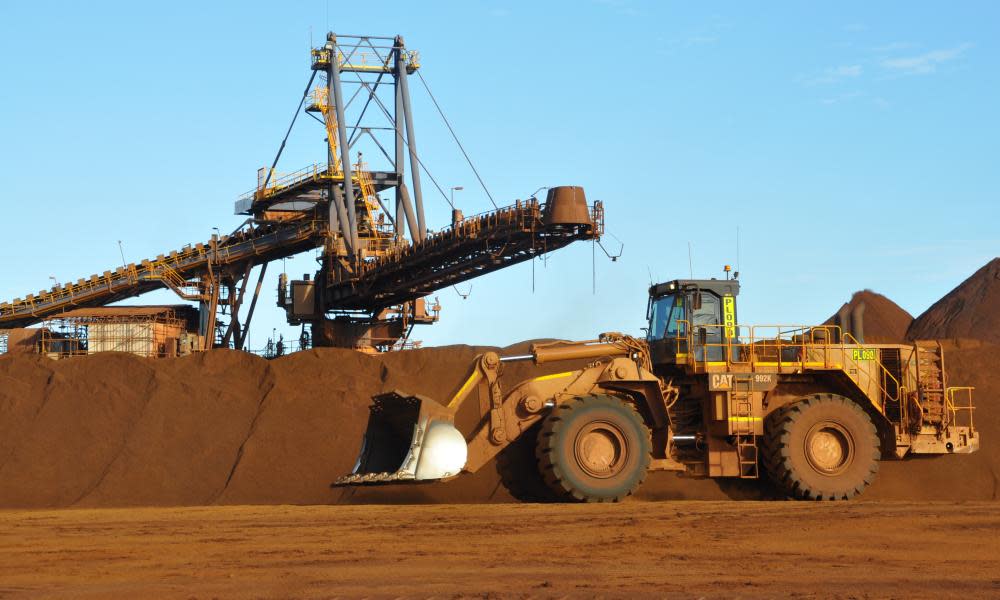An end to Australia’s iron ore export boom is just what the economy doesn’t need

It seems not all that long ago all the talk was about how gloriously the economy was going and how the Covid recession was in the past. But now the two states encompassing 55% of the nation’s economy are in lockdown and the second half of this year looks to be tough for the economy – especially as our iron ore exports might be about to take a hit.
One of weird things about the pandemic is that our major exports of iron ore and coal have seen an absolute prices boom:
If the graph does no display then click here
So massive was the surge of iron ore prices that in July they averaged a record high of US$214 ($291) per tonne.
The news was even better for Australian firms, because while the iron ore price rose, the value of our dollar did not, and so in July the iron ore spot price average was $290.12 per tonne – well above the previous peak of $220 per tonne that was reached just prior to the GFC in November 2007:
If the graph does not display then click here
Given the 2020-21 budget assumed that the spot price of iron ore would “decline to US$55/tonne free on board by the September quarter of 2021”, this has been quite a nice boon for the budget figures.
The most recent budget updates published by the Department of Finance showed company tax revenue for the 11 months up to May this year were $2.3bn ahead of what was estimated. That’s a nice pick up (but don’t worry, we will still be in a massive deficit).
It does, however, highlight just how our budget and our economy relies on our mining exports.
The pandemic of course has been utterly terrible for our services sector – including the exports side of it. International education and tourism have been completely smashed due to people being unable to enter the country.
Related: Australia urged to embrace stronger 2030 climate targets in ‘crucial’ fight ahead of Glasgow summit
As a result, while our iron ore exports have held up, the volume of Australia services exports have fallen back to 2006 levels – a point when our overall economy was roughly two-thirds the size it is now:
If the graph does not display then click here
This collapse meant that while the exports of goods is now just 1% below what it was in the last quarter of 2019, the volume of our services exports is down 44%.
Overall, that has meant the volume of total exports is down just over 10%.
That was not surprisingly bad news for our economic growth.
In the five years prior to the pandemic, we had truly entered the export phase of the mining boom. Exports were nearly equal to households in powering the growth of our economy – which is quite amazing when you consider that household spending makes up about 55% of our economy, and exports a quarter:
If the graph does not display then click here
But that all went kaput when the pandemic hit and our services sector was knocked to the canvas.
Since the start of 2020, exports have detracted 1.5 percentage points from GDP growth – ie theoretically if we took out our exports, Australia’s economy grew since December 2019 by nearly 3% rather than the 1.5% it has.
The good news is in the last three months of 2020 and the first three months of this year, things have picked up.
Our services exports kept falling, but goods exports picked up by more than enough, to the point were exports in that six-month period added 1 percentage point to GDP growth – second only to the impact of households spending madly during the lockdowns and on things other than holidaying.
So all good? Exports rising, prices rising, win-win? Well, alas, no.
In May, the Chinese government had had enough of the record high prices for the biggest component of its steel manufacturing and announced it would crack down on “excessive speculation”.
It was not a policy explicitly targeted at Australia, but implicitly it was very much part of the larger trade war between China and Australia.
And yet the price carried on at high levels until the start of this month when they plummeted – down 23% on the July highs:
If the graph does not display then click here
The prices now are around US$167 a tonne. And while that is a big fall, it really is only back to the levels in April so it’s not the greatest calamity.
Except last week China’s biggest steel producer, Baowu, announced it was cutting production.
Related: Pensioner slugged with jobkeeper debt accuses Coalition of double standards
There are numerous reasons for this – China is trying to target steel production in order to reduce its carbon emissions; the price of iron ore is also a big cost to its economy; and, heck, it also gives them a chance to slap Australia.
What it means, though, is that for the rest of the year, there could be a significant fall in the volume of our iron ore exports as well as further price falls.
At a time when our services sectors remain decimated and where foreign visitors are but a hope, this is decidedly not what our economy needed.
The latest lockdowns have made us all realise that the pandemic still has a way to go, and that also means the belief that our economy has weathered the storm and is out the other side is also one still to be translated into reality.
Greg Jericho writes on economics for Guardian Australia

 Yahoo News
Yahoo News 
